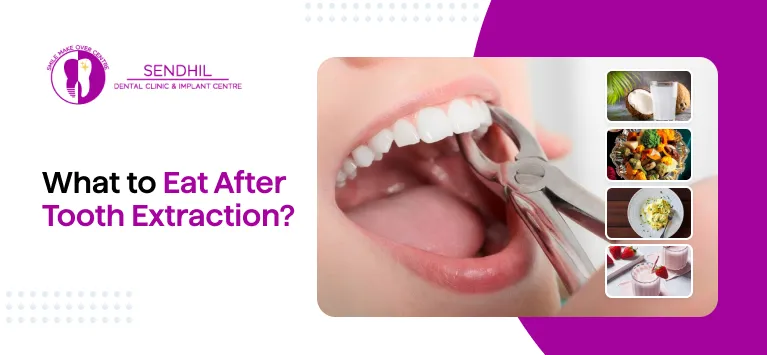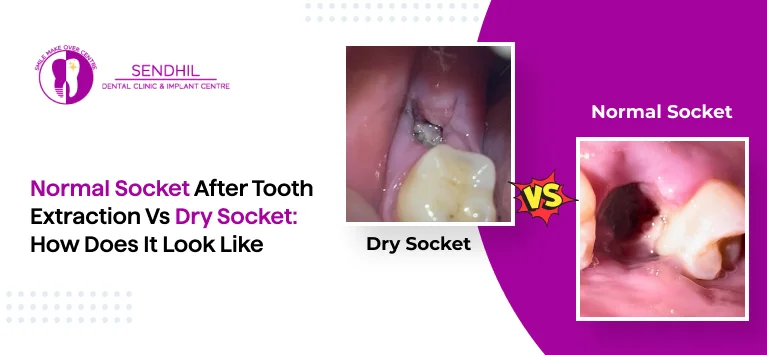
What to Eat After Tooth Extraction?
After a tooth extraction, your body begins the healing process immediately. Choosing the right foods and following proper post-extraction care can significantly impact your recovery, reducing discomfort and preventing complications such as dry sockets and infections. Eating the wrong foods or neglecting care may lead to prolonged pain and delayed healing.
In this blog, we will explore what to eat after tooth extraction, a list of soft foods to eat after wisdom teeth removal, and things to avoid after tooth extraction to ensure a smooth recovery.
Table of Contents
What Happens After a Tooth Extraction?
Tooth extraction creates an open wound in the mouth, and a blood clot forms in the empty socket to protect the underlying bone and nerves. If this clot gets disturbed, complications such as dry socket may arise, causing intense pain and slowing healing. That’s why it’s crucial to eat soft foods to eat after tooth extraction and adhere to proper post-extraction care instructions.
A healthy socket after tooth extraction is crucial for pain-free healing. Signs of a healthy socket include minimal bleeding, reduced swelling after a few days, and no signs of infection such as pus or foul odor.
Best Foods to Eat After Tooth Extraction
Choosing the right foods will aid in your comfort and support faster healing. Below is a list of soft foods to eat after wisdom teeth removal and other extractions:
1. Liquid and Pureed Foods
- Broths (warm, not hot) – Hydrating and rich in nutrients, broths help maintain strength while being gentle on the extraction site.
- Smoothies (without using a straw) – Blended fruits and yogurt provide vitamins and protein to support healing. Avoid using a straw to prevent dry sockets.
- Applesauce – A great source of vitamin C and fiber, applesauce is easy to eat without irritating the gums.
- Blended soups – Cream-based soups provide protein and comfort without requiring chewing.
- Milkshakes (without a straw) – A delicious way to get calories, but avoid straws to prevent suction-related complications.
2. Soft Dairy Products
- Yogurt (plain or fruit-based) – Packed with probiotics, yogurt supports digestion and promotes overall healing.
- Cottage cheese – A high-protein option that is soft and easy to swallow without much effort.
- Soft scrambled eggs – Eggs are a rich source of protein, iron, and essential nutrients to speed up recovery.
3. Mashed and Cooked Foods
- Mashed potatoes (smooth, without chunks) – Soft, creamy, and rich in carbohydrates for energy replenishment.
- Mashed bananas – Naturally sweet, bananas are packed with potassium and easy to eat.
- Cooked and soft vegetables – Steamed or boiled veggies like carrots and squash provide essential vitamins without being too hard to chew.
- Soft pasta – A great way to get carbohydrates while ensuring an easy-to-eat texture.
4. Protein-Rich Soft Foods
- Scrambled or poached eggs – High in protein and easy on the extraction site.
- Soft tofu – A vegetarian-friendly protein source that requires no chewing.
- Flaky, well-cooked fish – Omega-3 fatty acids in fish help reduce inflammation and support healing.
- Hummus – Made from blended chickpeas, hummus is a creamy and nutritious addition to a soft diet.
5. Hydration and Healthy Drinks
- Water – Staying hydrated is essential for faster healing.
- Herbal teas (lukewarm) – Helps soothe the mouth while keeping you hydrated.
- Coconut water – A natural electrolyte drink that keeps your body nourished.
- Protein shakes – A great option for those who need extra nutrients but cannot chew solid food.
These soft foods to eat after wisdom teeth removal will help prevent irritation, making your recovery more comfortable.
Things to Avoid After Tooth Extraction
Certain foods and habits can cause complications, dislodge the blood clot, or increase pain and swelling. Here are some things to avoid after tooth extraction:
1. Hard and Crunchy Foods
- Chips – Sharp edges can irritate the extraction site.
- Nuts – Hard to chew and can get lodged in the wound.
- Popcorn – The hulls can cause irritation or infection.
2. Spicy and Acidic Foods
- Citrus fruits – Can cause a burning sensation in the extraction area.
- Spicy curries – This can lead to discomfort and increased sensitivity.
- Vinegar-based foods – May irritate healing tissues.
3. Chewy or Sticky Foods
- Gum – Can dislodge the clot and cause complications.
- Caramel – Sticks to teeth and is difficult to remove.
- Tough meats – Requires excessive chewing, which can strain the mouth.
4. Hot and Carbonated Drinks
- Coffee (if too hot) – Can interfere with the blood clotting process.
- Soda – Carbonation can irritate the wound.
- Alcoholic beverages – Can slow healing and increase bleeding risk.
5. Alcohol After Tooth Extraction
- Avoiding alcohol after tooth extraction is essential as it can delay healing and interfere with pain medications.
Essential Care After Tooth Extraction
Proper post-extraction care helps to minimize complications and accelerate healing. Follow these steps for the best results:
- Rest and Avoid Strenuous Activities: Overexertion can increase swelling and bleeding.
- Apply an Ice Pack: Helps reduce pain and swelling within the first 24 hours.
- Keep the Extraction Site Clean: After 24 hours, rinse gently with salt water to prevent infections.
- Avoid Using Straws: This prevents suction pressure that could dislodge the blood clot, leading to a dry socket.
A healthy socket after tooth extraction should show gradual healing with minimal pain. If you experience excessive pain or swelling, consult your dentist.
First Night After Tooth Extraction: What to Expect
The first night after tooth extraction is crucial for proper healing. Here’s how to ensure a comfortable recovery:
- Sleep with your head slightly elevated to minimize bleeding and swelling.
- Change gauze pads as needed, keeping light pressure on the site.
- Avoid sleeping on the extraction side to prevent irritation.
- Stick to soft foods to eat after wisdom teeth removal for minimal discomfort.
How to Stop Bleeding After Tooth Extraction
Mild bleeding is normal, but persistent bleeding requires attention. To manage it effectively:
- Bite on a gauze pad for 30-45 minutes with firm but gentle pressure.
- Avoid spitting or rinsing aggressively.
- If bleeding continues, bite on a damp tea bag, as tannins help blood clotting.
- Contact your dentist if heavy bleeding persists beyond 24 hours.
Signs of Infection After Tooth Extraction
An infection after tooth extraction can slow healing and cause further complications. Watch for these warning signs:
- Persistent pain or swelling beyond three days
- Fever or chills
- Foul breath or pus at the extraction site
If you experience any of these symptoms, seek immediate dental attention.
Eating After Tooth Extraction: Best Practices
To make eating after tooth extraction easier and safer:
- Take small bites and chew on the opposite side of your mouth.
- Avoid extreme temperatures—eat at room temperature.
- Stay hydrated but skip carbonated and sugary drinks.
What Does Wisdom Teeth Look Like?
Many people wonder, what does wisdom teeth look like? Wisdom teeth are the third molars located at the back of your mouth. They usually appear in your late teens or early adulthood. If they are impacted or causing crowding, extraction may be necessary.
Conclusion
Following the right dietary choices after an extraction is crucial for a smooth recovery. Stick to soft foods to eat after tooth extraction, avoid harmful foods, and practice proper care after tooth extraction to ensure fast healing. If you experience prolonged pain, swelling, or signs of infection, consult your dentist immediately.





